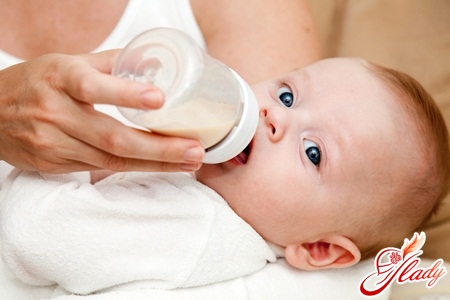 All young parents are extremely interested inabsolutely everything that is connected with children. Including the features of the digestive system in children. The fact that the digestive system of crumbs differs from that in adults is not in doubt. But what exactly are these differences? This is what we will try to find out today in this article.
All young parents are extremely interested inabsolutely everything that is connected with children. Including the features of the digestive system in children. The fact that the digestive system of crumbs differs from that in adults is not in doubt. But what exactly are these differences? This is what we will try to find out today in this article.
And how did it all start?
And let's start talking about featuressystem of digestion in children from the very beginning, namely - from the moment of implantation of the egg into the mucous membrane of the uterus. After all, and at this stage of development, nutrition to the fetus is simply vital. Once the embryo is implanted in the uterus, it begins to feed the secret, which is produced by the mucous membrane of the uterus. After about a week the embryo begins to feed on the contents of the yolk sac. And already approximately from the middle of the second month of pregnancy the food of crumbs becomes hemotrophic - that is, the fruit receives nutrients from the mother's body, with the help of the placenta. However, the digestive system of the fetus itself does not stand aside: it takes a direct part in the processing of such nutrients as protein, water, glucose and the like, which it receives from the mother's body. Despite the fact that the maturation of the digestive system in the fetus is extremely fast, the child appears with a very significant physiological immaturity of the salivary glands, pancreas, liver and other organs responsible for proper digestion. Fortunately, nature is extremely wise. She foresaw and this is the first few months after the appearance of crumbs, the only food for him is breast milk. Maternal milk is not only easily absorbed by the immature digestive system of crumbs, but also completely satisfies all its physiological needs. By the way, all this is true for artificial milk mixtures. Although, of course, if you can breastfeed, it is better to give preference to mother's milk.
Salivary glands
Anatomical formation of salivary glands of crumbsends at the time of birth. But the secretory function of the salivary glands is still far from ideal. And they will begin to function fully only in 4 - 5 months. By the way, the active production of saliva, which occurs in a child at this age, is often taken by parents for the signal that the teeth begin to be cut. In fact, the strong salivation in the crumb is due to the pronounced immaturity of the mechanisms governing salivation and ingestion. Saliva plays a very important role in digestion crumbs - the first few months of life it is necessary to properly seal the mouth during sucking. In addition, it is with the help of saliva that small clots of casein are formed - a substance contained in breast milk. And even at the time when the first food is introduced into the baby's diet, the role of saliva can not be overemphasized. It is simply necessary in order to form the right food lump. If this does not happen, then it is very likely that the baby develops various problems with digestion.
Pancreas and liver
By the time of appearance of crumbs in the light of itThe pancreas is still relatively immature. Although it is very easy to cope with the digestion of those easily assimilated nutrients that are found in breast milk or artificial milk mixtures. By the way, if the baby is on artificial feeding, the pancreas ripens much faster. In all the other crumbs that eat molochko milk, the final maturation of the pancreas occurs at a time when they begin to introduce complementary foods into their diet. It is the pancreas that supplies the duodenum with juice containing enzymes such as lipase that breaks down fats and trypsin that breaks down carbohydrates. Well, of course, it is the pancreas that produces the hormone insulin, which plays a huge role in the regulation of carbohydrate metabolism. In the event that insulin is produced in insufficient quantities, the likelihood of developing such an unpleasant disease as diabetes is very high. The pancreas secretes pancreatic juice into the duodenum, which contains enzymes: trypsin, digesting proteins, lipase, fat-splitting, amylase, which breaks down carbohydrates. In addition, the pancreas produces hormone insulin, which is the main regulator of carbohydrate metabolism. With insufficient insulin production, a serious illness develops - diabetes mellitus. Liver. Despite the fact that the size of the liver of a newborn child is sufficiently large, it is still far from functional maturity. The isolation of those bile acids, which are necessary for digesting solid foods, is still too small. It starts around the same time, when extra food is introduced into the ration of crumbs. At the time of appearance of crumbs, his liver is about twice as large as that of an adult. Of course, as a percentage of body size. But, as already mentioned above, the baby's liver is still very, very immature. Although, despite this, the liver successfully copes with many functions assigned to it. The liver is a true storehouse of many nutrients, for example fats, glycogen, proteins. And another extremely important function of the liver is antitoxic. It is the liver that is one of the main "filters" that remove all toxic substances from the human body. 
Stomach
Despite the fact that the volume of the stomach inThe newborn child is rapidly increasing, its secretory function is extremely weak. Its full functioning begins approximately on 9 - 10 month of a life of the kid. Yes, and the anatomical and physiological features of the stomach crumbs are very peculiar. The bottom of the stomach is very weakly developed, like the entire muscular layer. But the entrance to the stomach of a young child is still wide enough. It is the combination of all these three factors that leads to the fact that young children often regurgitate. Yes, and their vomiting is also quite common phenomenon. Although, of course, contributes and ingestion of a crumb of air during sucking. The mucous membrane of the baby's stomach is extremely tender, abounds with blood vessels. The stomach of the child has all the same glands that there are in adults. And that is why in the gastric juice of the child contains almost all the "adult" components, such as rennet, pepsin, hydrochloric acid, lipase and many - many others. However, of course, in a completely different percentage than in adults. So, for example, rennet enzyme is extremely important for digestion of the child - it causes milk curdling. By the way - women's milk is curved more slowly than cow's milk, on the basis of which most of the milk formulas are made. After draining the milk, pepsin enters the case, which is designed to break down the proteins of milk. A splitting of fats occurs under the influence of lipase.
Oral cavity
Oral cavity of the child also has its ownfeatures, one way or another related to sucking milk. The oral cavity of the crumb is still very small - because of the low sky, which does not yet have a vault. The tongue of a small child is wide and short, with pronounced papillae. In addition, the child is extremely well developed chewing muscles. It is thanks to this whole complex of crumbs that you can very tightly grasp the nipple of the mother's breast. In his mouth creates a negative pressure, so that the milk enters the mouth of the baby. If the crumb was born full, all of his sucking and swallowing reflexes are very well developed. The mucous membrane of the mouth of the child is extremely rich in blood vessels, but very dry. Remember, we talked about the fact that saliva in babies of the first months of life is not yet fully produced. All the food consumed by the child is liquid, so there is no problem. But here it is worth to remind parents that, because of the increased dryness of the oral cavity, the mucous membrane is particularly sensitive. Therefore, it is necessary to treat it with increased attention and caution. Take care that the child does not pull into his mouth coarse diapers, toys. Otherwise, abrasions and wounds may appear on the surface of the mucous membrane of the child. These injuries are extremely painful and can lead to the child not being able to suck out the amount of milk he needs. In the saliva of a child, as, indeed, any other person, contains various enzymes that begin to break down food in the mouth. Of course, we are now talking about lure, not milk.
Intestines
An intestine plays an equal role in digestion. In infants, the intestine compensates for the immaturity of all other organs of the digestive system. After all, it is the baby's intestines that are responsible for the membrane digestion, so topical for the crumbs, the mother's milk or milk formula. It is in the intestines that the nutrients split instantly into their constituents. And already from the intestine these very nutrients are absorbed into the blood. As the food that gets into the stomach is digested, under the influence of peristalsis of the intestine it moves into the intestine. Its first stage is the duodenum, where, under the action of enzymes produced by the pancreas and liver, further digestion takes place. Leaving the duodenum, food enters other parts of the small intestine, where it continues to be digested already under the influence of intestinal juices. This is where the process of digestion of food ends. Incidentally, the length of the intestine in a child is twice that of an adult - it is six times larger than the height of a crumb. The intestine of the child has a very active peristalsis - he makes two types of movements:
- Wormlike movements
With the help of this type of movement, food moves through various parts of the intestine. Without these movements, the normal process of digestion is simply impossible.
- Pendulum movements
With the help of pendulum movements,directly the process of digestion of food, as well as its subsequent absorption into the blood of a person - in this case a child. Normally, the peristalsis of the intestine in an adult occurs under the influence of food that has got into it. However, in children, peristalsis can arise and increase not only because of the mechanical effects of food, but also under the influence of several other factors: prolonged crying of the child, overheating, excessive physical activity. The mucous membrane of the intestine of the child is extremely tender and sensitive, and its walls possess exceptionally high permeability. That is why intestinal infections and toxins are a particular danger for a small child. They very quickly penetrate through the intestinal wall into the circulatory system, thereby provoking the development of intoxications, sometimes very strong. In young children, the most common food poisoning can result in such severe consequences as heart failure, meningitis and others. 
Germs of the gastrointestinal tract
During the intrauterine development of the intestines of crumbsabsolutely sterile. However, just a few hours after birth, the intestines of the baby colonize a large number of very diverse bacteria. They disappear into the body of the child through the nose, mouth, anus. Approximately on the second day after a birth in excrements of a crumb it is possible to find a huge quantity of the most various bacteria. And in the stomach, or in the upper intestine, there are practically no bacteria. Basically, they are localized in the large intestine and lower part of the small intestine. What exactly microbes predominate in the intestines of a child depends solely on the nature of the infant's feeding. In the event that the child is fed by mother's milk, which is extremely rich in carbohydrates, the bacteria in the intestine of the baby will predominantly be those necessary for the fermentation of carbohydrates. It is this microflora that is physiological for the infant. In the same case, if a child receives artificial milk mixtures made on the basis of cow's milk, his intestine is dominated by E. coli. Unfortunately, this intestinal microflora for a child is no longer physiological. Therefore, under the influence of unfavorable factors, they can provoke the development of various intestinal diseases. That is why most often intestinal disorders affect those children who are on artificial feeding.
Children's chair
You can not ignore the question of the chair of the child. After all, in infancy, kidney defecations can tell a lot about his health. Within the framework of the physiological norm, in the first 24 hours after birth, the original calmoconium should be excreted in the child. Meconium has a viscous oily consistency and dark green light. Meconium has no smell and is sterile. It is formed in the intestines of the baby during intrauterine development - from digestive juices, swallowed amniotic fluid and intestinal epithelium. Normal bowel movements appear about the third day. They consist mainly of the remains of not digested milk, digestive juices, salts and bacteria. In children of the first months of life, the stool is, as a rule, two or three times a day. However, very often the chair in the first four - five weeks of life is much more often - 8 - 9 times a day, sometimes even has a liquid consistency. Of course, almost all mothers are very much frightened, believing that the baby is very sick. However, in the event that the child's general well-being does not suffer in any way, the baby eats well and adds weight as part of the norm, this frequent chair should not be treated with increased anxiety. Of course, what to say about this doctor - a pediatrician is still necessary. However, in most cases, doctors associate this phenomenon with the insufficiently rapid adaptation of crumbs to the still new conditions of life outside the mother's body for him. Especially often this happens in children who hurried to be born, or were born weakened and with a small body weight. However, there is also a reverse situation in which the children who eat the same mother's milk, the chair is only once every two to three days. And this is explained very simply - mother's milk is digested very well. And it is absorbed almost completely, which means that there is practically no waste left. By the way, those kids who feed on artificial mixtures made on the basis of cow's milk, feces have a darker color, a thick consistency and a more unpleasant smell. As the child grows up, the stool becomes less and less common. However, of course, to the full maturity of digestion is still very far. Completely maturation of the digestive tract ends only by 15 - 16 years. Until then, parents will have to take into account the peculiarities of digestion in children all the time, making up their menu. We advise you to read:









